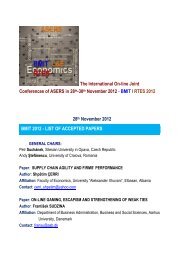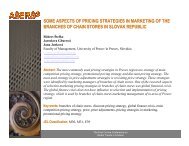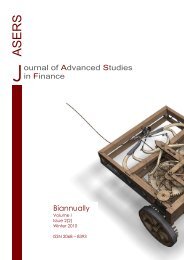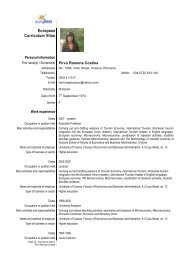Can Shift to a Funded Pension System Affect - ASERS
Can Shift to a Funded Pension System Affect - ASERS
Can Shift to a Funded Pension System Affect - ASERS
You also want an ePaper? Increase the reach of your titles
YUMPU automatically turns print PDFs into web optimized ePapers that Google loves.
Theoretical and Practical Research in Economic Fields<br />
Once established that a long run cointegration exists, Equation (3) is estimated. A maximum lag order of one<br />
is allowed in the ARDL model using the Schwarz Bayesian Criteria since it presents the smaller residual sum of<br />
squared. The following ARDL (4,3,2,3) specification is used.<br />
Table 5 reports the results of the ARDL where the regressions fit reasonably well and pass the main<br />
diagnostic tests. All levels estimates are highly significant and have also the expected signs. The results suggest that<br />
there is a strong evidence between what the theory predict (about the relationship between savings and pension<br />
funds) and the estimated variables. The constant term is positive and highly significant at 0.01 level.<br />
The estimated retirement savings variables (RPENS, RPAYG and RINS) show the coefficients with correct<br />
signs and are statistically significance at 0.01 and 0.05. The variable DR is with the right signs and statistically<br />
significant at 0.01 level.<br />
Section 1, Short-run coefficient estimates<br />
Table 5. ARDL (4,3,2,3) Equation (3)<br />
Lag order 1 2 3 4<br />
ΔSAV 0.6874** 0.3213** -0.1703*<br />
( 8.971) ( 3.466 ) ( -1.972)<br />
ΔRINS 7.9250**<br />
(4.0295)<br />
ΔRPENS<br />
0.25532 ♦<br />
(1.6884)<br />
ΔRPAYG 9.9141**<br />
( 4.0232)<br />
ecm<br />
-0.028164 ♦<br />
(-1.8313)<br />
Section 2, Long-run coefficient estimates<br />
C RINS RPAYG RPENS DR<br />
1.679842** 0.62959* -0.93436* 0.09025* -0.128499**<br />
(3.156399) (2.352) (-2.3852) (1.689) (-4.0493)<br />
Dummy4 -0.04248*<br />
(-2.2338)<br />
Section 3 Diagnostics<br />
Adjusted R-squared: 0.84591; Durbin-Watson stat: 1.8272;<br />
Serial Correlation 2 SC(2) 1.412[0.235] ;<br />
Functional Form 2 FF<br />
(1) 0.52528[0.469] ;<br />
Normality 2 N<br />
(2) 6.847[0.6321] ;<br />
Heteroscedasticity 2 H<br />
(1) 0.33334[0.564] .<br />
♦significant at the 0.10 level; *significant at the 0.05 level; **significant at the 0.01 level ; Obs. 152 ( monthly)<br />
The results of Equation(3) for the short run estimations show the complex dynamics that seem <strong>to</strong> exist<br />
between changes in saving and changes in the pension funds. The coefficients are all significant. Among them,<br />
ΔRPENS is the only one statistically significant at 0.10 level.<br />
The equilibrium correction coefficient (ecm), estimated (-0.028) is statistically significant at 0.10 per cent and<br />
has the correct sign, implying that a deviation from the long-run equilibrium, following a short run shock, is corrected<br />
by about 2.8 per cent after one month. Finally, Table 5 (Section 2) shows the results of the dummy4 used 17 . It is<br />
statistically significant at 0.01 level and the coefficients‟ value is -0.0242.<br />
Overall, our results are consistent with the ones by Granville and Mallick (2004) that found evidence<br />
suggesting that increases in manda<strong>to</strong>ry pension funds financial assets increase national saving.<br />
As regards the relation between dependency ratio and changes in national saving, it should be noted that<br />
population ageing will itself generate changes in saving which may have a major macroeconomic impact.<br />
According <strong>to</strong> the life cycle theory, savings rates tend <strong>to</strong> decline in countries where there are larger numbers of<br />
17 We made estimations including all the dummies selected in 4.2.2. and dropped those not significant.<br />
22











